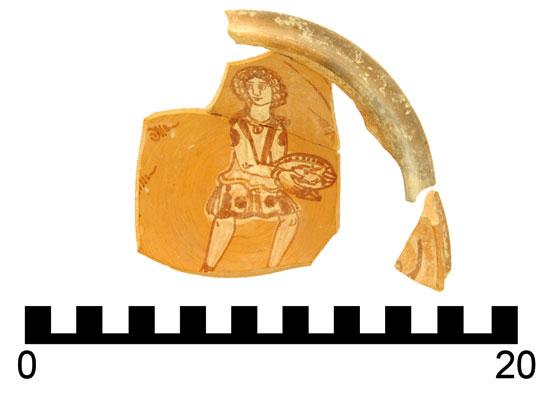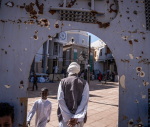You are here
Danish-German project seeks to shine light on ancient Jerash’s pottery production
By Saeb Rawashdeh - Sep 02,2020 - Last updated at Sep 02,2020

Jerash Bowl with servant figure, dating to the Byzantine period, 6th century AD. These fine-ware plates were produced in Jerash and exported in the Near East, according to scholars (Photo courtesy of Danish-German Jerash Northwest Quarter Project)
AMMAN — From the Roman period to Early Islamic times, Jerash had a “strong and continuous” pottery production, according to two scholars who are members of a Danish-German archaeology team.
From the excavations in the Northwest Quarter of ancient Gerasa (Jerash) numerous pottery finds had emerged and these had come to light during five campaigns undertaken by a Danish-German team between 2012 and 2016, noted Danish archaeologist Professor Rubina Raja.
According to Professor Achim Lichtemberger, who is also a member of the team, the Danish-German Jerash Northwest Quarter Project (carried out by universities of Aarhus and Muenster) has implemented total quantification of all finds, including pottery.
“The oldest ceramic object hitherto found in our excavations is a fragment of a neat black glazed pate from the Hellenistic period [2nd or 1st century BC]”, said Professor Raja.
The ceramic object was imported from Greece and belonged to the settlement of Hellenistic Gerasa, the scholar added.
“Also in other areas of Jerash, pottery from the Hellenistic period has come to light, but in general Hellenistic pottery is scarce in the excavated material,” said Raja.
During the five years of excavations the team registered and identified a total of 758.647 pieces of pottery, Lichtenberger said
“This is a lot considering that our excavation is fairly small. It is the first time that a total quantification of pottery has been undertaken in an excavation in Jerash and it allows us to undertake a range of statistical analyses,” Lichtenberger said.
Ninety-nine per cent of the pottery was produced locally and only 1 per cent was imported, he added.
Since Jerash was an active production place of pottery, we have to assume that products were exported to villages and cities in the vicinity and beyond. However, it is difficult to trace this, but natural science methods are useful for understanding the origin and provenance of ceramic products,” Raja said.
The Danish-German Jerash Northwest Quarter Project has done a “pioneering work” in petrographic studies and that it managed to identify the local geochemical fingerprint of pottery, but “research is still in an early stage and much research remains to be done, especially for other sites such as Amman, Pella, Abila, Umm Qeis to compare the data with our results,” Raja noted.
Related Articles
AMMAN — A Danish-German project is attempting to address the problem of poorly-documented mediaeval material found at sites like Jerash with
AMMAN — Though common ware pottery have been found in great number at classical excavations throughout the world, little attention has hithe
AMMAN — Although the focus of the archaeological research conducted in Jerash has been centred on the main road, the Danish-German Jerash No
















